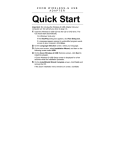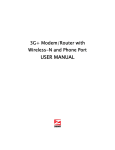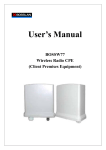Download Zoom 4420-A Network Router User Manual
Transcript
AP+4 U S E R G U I D E Contents Overview........................................................................... 5 Installing the AP+4 .......................................................... 6 Connecting the Hardware............................................... 7 Setting Up the AP+4....................................................... 8 Monitoring AP+4 Status ................................................ 16 Operating Mode ............................................................. 19 Wireless Configuration ................................................. 20 Basic Settings .............................................................. 20 Active Wireless Client Table......................................... 23 Wireless Security.......................................................... 24 Access Control ............................................................. 27 WDS Settings ............................................................... 28 Site Survey ................................................................... 29 Advanced Settings ....................................................... 31 WiFi Protected Setup™ (WPS) .................................... 34 TCP/IP Settings.............................................................. 37 LAN Interface ............................................................... 37 WAN Interface .............................................................. 39 Firewall Settings ............................................................ 50 Port Filtering ................................................................. 50 IP Filtering .................................................................... 52 MAC Address Filtering ................................................. 53 URL Filtering ................................................................ 54 Port Forwarding............................................................ 55 2 DMZ ............................................................................. 56 Denial of Service .......................................................... 57 VPN Settings .................................................................. 61 VPN Setup (Client) ....................................................... 63 Advanced VPN Settings for IKE ................................... 67 Management................................................................... 69 Statistics ....................................................................... 69 DDNS ........................................................................... 70 Time Zone Settings ...................................................... 72 Log ............................................................................... 73 Upgrade Firmware........................................................ 75 Save/Reload Configuration .......................................... 76 Password Setup ........................................................... 77 Troubleshooting ............................................................ 78 Zoom Customer Support .............................................. 83 Regulatory Information ................................................. 85 3 Package Contents The AP+4 package contains the following: • AP+4 • Quick Start • Power cube • CD containing warranty information and • Ethernet cable this documentation If anything is missing or damaged, please contact Zoom Customer Support or the vendor from whom you purchased the AP+4. 4 Overview You can use the AP+4 as a Router/Access Point, Universal Repeater, Ethernet Client or Wireless ISP. • As a Router/AP, the AP+4 handles local network traffic both wirelessly and through its four LAN (Local Area Network) ports, and communicates via its WAN (Wide Area Network) port to an ADSL modem, cable modem, or other Internetconnected device. • As a Repeater, the AP+4 is placed near the edge of a wireless network – for example, a Zoom X6 network – and wirelessly links up to 200 more devices to the network. • As an Ethernet Client, the AP+4 connects via its LAN ports to up to four game consoles or computers, and links them wirelessly to a Zoom X6 or other wireless router. • As a Wireless ISP, the AP+4 can connect up to four wired PCs or game consoles, give them Network Address Translation protection, and connect them wirelessly to an access point. If you select this mode, use the Wireless Basic Setup page to configure the AP+4 as a wireless client. See Setting Up the AP+4 on page 8 to choose an operating mode. This User Guide provides instructions for connecting and configuring your AP+4 and setting up wireless and wired local area networks. It includes details about security, firewalls, Virtual Private Networks and administrative tasks. When we update information about the AP+4, the information is provided at this Zoom web site: http://www.zoom.com/techsupport/wirelessg_support.html 5 1 Installing the AP+4 This chapter provides basic instructions for connecting the hardware and configuring the AP+4 using the Setup Wizard. If you have already done this by following the instructions in the printed Quick Start, skip to Chapter 2, Wireless Configuration, on page 20. AP+4 Back Panel Connectors 6 Connector Description WAN This port connects to the LAN or Ethernet port of an ADSL or cable modem, using an Ethernet cable. LAN 1 - 4 These Local Area Network ports connect via Ethernet cable to up to four computers, game consoles or other network devices. PWR This port connects to a live power source using the supplied power cube. RESET To reset the modem to its factory settings, insert a paper clip and press and hold for 10 seconds. Zoom AP+4 User Guide Connecting the Hardware 1 Put the AP+4 near a computer to be used for setup. That computer needs an Ethernet (LAN) port. 2 Turn off the computer. 3 Connect one end of the supplied power cube to the AP+4 PWR jack, and the other end to a live power source. Important! Only use the power cube shipped with the AP+4. Other power cubes may damage the device. The PWR LED on the AP+4 front panel should turn on and the WLAN LED should flash. (The WLAN LED continues to flash to signify broadcast activity as long as the Wireless LAN is enabled. It is enabled by default.) 4 Connect one end of the supplied Ethernet cable to the computer’s Ethernet port and the other end to one of the AP+4’s LAN ports. 5 Turn on the computer. The WLAN LED continues flashing and the connected LAN port and the ACT (Activity) LEDs become steady on. (If you have a 10 Mbps Ethernet connection, the LAN LED does not turn on.) If you want the AP+4 to have access to the Internet, connect its WAN port to the Ethernet port on your cable modem, ADSL modem, or other broadband device. When you do this, the WAN LED turns on if the broadband device is on and its Ethernet port is working. Chapter 1. Installing the AP+4 7 LED Status The AP+4 is . . . PWR Steady connected to a power source WLAN Flashing broadcasting its SSID (network name) Steady not broadcasting its SSID and therefore not available to wireless devices seeking a wireless network connection Steady connected either wirelessly or via Ethernet cable to a broadband modem that connects to the Internet Flashing transmitting or receiving data LAN 1-4 Steady connected via Ethernet cable to up to four computers or gaming devices ACT (Activity) Steady connected via the associated LAN port to a computer or other network device transmitting or receiving data via the associated LAN port WAN Flashing Setting Up the AP+4 1 Open your web browser, enter 10.0.0.200 in the address bar, and press the Enter key to open the Zoom AP+4 configuration software. The Status page appears first. 2 In the left pane, select Setup Wizard. 3 On the Welcome page, click Next. 8 Zoom AP+4 User Guide 4 On the Choosing an Operating Mode page, select the way you want to use the AP+4: Router/Access Point. In this mode, which is the one most users will select, the AP+4 links all wireless enabled computers and other devices to a network and gives those devices shared access to your broadband Internet connection. If you are using the AP+4 as a Repeater, on the Wireless Basic Setup page at the Mode option, select AP+WDS. Then, on the WDS Settings page, enter the MAC addresses of access points you are communicating with. Ethernet Client. This mode lets up to four computers, game consoles or other devices plug into the AP+4 for wireless access to a wireless network. (In this mode, the AP+4 acts as a full bridge, just passing data back and forth between the Internet and network devices.) Wireless ISP. In this mode, the AP+4 connects to the Ethernet ports of up to four wired PCs or game consoles, and connects those devices wirelessly to a wireless access point. Use this mode if you know you need to use the AP+4's NAT functionality. Most users who need to connect a computer or game console to an access point should set up the AP+4 as an Ethernet Client instead. If you select Wireless ISP mode, use the Wireless Basic Setup page to configure the AP+4 as a wireless client. Click Next to continue. Chapter 1. Installing the AP+4 9 5 To have the AP+4’s clock automatically updated by an NTP server, on the Selecting a Time Zone page, select a Time Zone and an NTP Server, and click Next. 6 If you need to set up or modify your wired local network, use the LAN Interface Setup page (see page 37 of this manual for more information). 7 If you want to connect to the Internet, select the method on the Setting Up Internet Access page. 10 • If you are among the great majority of customers who are using the AP+4 as a Router/Access Point or with a cable modem, at WAN Access Type select DHCP Client. • If you select DHCP Client and at the end of the installation process you have not connected successfully to the Internet, it is possible that you are running PPPoE software. In that case, at WAN Access Type select PPPoE (Point-to-Point Protocol over Ethernet). Then enter the User Name and Password given to you by your service provider. Zoom AP+4 User Guide • If you are using the AP+4 as an Ethernet Client or a Repeater, at WAN Access Type you should also select DHCP Client unless you have requested a Static IP from your Internet Service Provider. If so, select Static IP and enter the values for IP Address, Subnet Mask, Default Gateway and DNS Server that you want to use on your network. • If you are setting up a Virtual Private Network (VPN) select PPTP. (Your ISP will tell you if you need to select this protocol. Most people don't.) Click Next to continue. 8 On the Configuring the Wireless Network page, enter your wireless network parameters. • At Band, select the type(s) of devices in your network: ¾ B+G if the network includes both 802.11b and 802.11g devices (default). This option is best for most users. ¾ B if the network includes only 802.11b devices Chapter 1. Installing the AP+4 11 ¾ • G if the network includes only 802.11g devices At Wireless Operation, select ¾ AP if you are using the AP+4 as a Router/Access Point or a Repeater ¾ Client if you are using the AP+4 as an Ethernet Client ¾ WDS if you want to use the AP+4 as a Repeater in WDS (Wireless Distribution System) mode. ¾ AP+WDS if you want the AP+4 to operate as both an Access Point and a Repeater in WDS mode. • At Network Type (available only if the AP+4 is operating as a Client) select Infrastructure (most users) or Ad Hoc. • At SSID (Service Set IDentifier), enter a network name. All wireless devices on your network should use the same name. • At Channel Number (available only if you selected Ad Hoc channel as your Network Type), select a channel number that isn’t being used by another nearby network. If you are unsure which channel to use, try Channel 6. • Select Enable MAC Clone if for some reason you want to use the MAC address of a device in the network instead of the AP+4’s MAC address. • Enable Universal Repeater Mode (unavailable) ¾ SSID of Extended Interface (unavailable) Click Next to continue. 12 Zoom AP+4 User Guide 9 On the Setting up Wireless Security page, select an encryption method to protect your wireless communication. We strongly recommend that you set up security. Note: If all the wireless devices on your network use WPA2 or WPA security, you can automatically configure WPA2 or WPA on each device using the Wi-Fi Protected Setup (WPS) page on the AP+4 Advanced Setup menu. See page 34. If you do not choose to use WPS, at Encryption select a security method. • Select WPA2 (AES) if all of the devices in your network support this method. Note: If you are not sure of the encryption method, check the documentation that came with the device(s). In the Pre-Shared Key Format list, select Passphrase or Hex (64 characters). We recommend that you select Passphrase. In the Pre-Shared Key text box, if you selected Passphrase, enter a password or sentence. If you selected Hex, enter up to 64 hexadecimal values. Enter the Passphrase or Hex string here for future reference: ——————————————————— Chapter 1. Installing the AP+4 13 • Select WPA2 Mixed if some of the devices in your network support WPA2 and some support WPA, and then follow the instructions for WPA2 above. • Select WPA (TKIP) if all the devices in your network support this method, and then follow the instructions for WPA2 above. • Select WEP only if the devices in your network do not support WPA2 or WPA. In the Key Length list, select 64 bits or 128 bits (128 bits preferred). In the Key Format list, if all the wireless devices in the network are Zoom products, select ASCII. Otherwise, select Hex. In the Default Tx Key list, select Key 1 (the default). In the Encryption Key 1 text box, enter Key 1 in the format you selected, Hex or ASCII. If you selected Hex and you chose a 128-bit key length, write your 26-hexadecimal key in the space below for future reference, and then enter the key in the Encryption Key 1 box. — — — — — — — — — — — — — — — — — — — — — — — — — — If you selected Hex and you chose a 64-bit key length, write your 13-hexadecimal key in the space below for future reference, and then enter the key in the Encryption Key 1 box. — — — — — — — — — — — — — If you selected ASCII and you chose a 128-bit key length, write your 13-ASCII-character key in the space below for future reference, and then enter the key in the Encryption Key 1 box. — — — — — — — — — — — — — 14 Zoom AP+4 User Guide If you selected ASCII and you chose a 64-bit key length, write your 5-ASCII-character key in the space below for future reference, and then enter the key in the Encryption Key 1 box. — — — — — Click Finished, and at the Settings changed successfully! message, click OK. Your basic setup is complete. You don’t need to keep the AP+4 plugged into the setup computer. • If you are using the AP+4 as a Router/Access Point, your broadband modem is already connected. You can plug up to four computers, game consoles, or other devices into the AP+4’s LAN ports. The AP+4 can also link wireless devices to your network. • If you are using the AP+4 as a Repeater, you can unplug the computer from the AP+4’s LAN port and locate the AP+4 near the edge of the wireless network you want to extend. • If you are using the AP+4 as an Ethernet Client or Wireless ISP to provide access to your wireless network, you can plug up to four computers, game consoles, or other devices into the AP+4’s LAN ports. If you decide that you want to make changes to any of the parameters you have configured using the Setup Wizard, turn to Chapter 3, Operating Mode. Continue with Chapter 4, Wireless Configuration, and Chapter 5, TCP/IP Settings. Chapter 1. Installing the AP+4 15 2 Monitoring AP+4 Status The Status page is displayed when you open the AP+4 configuration software: Field Data displayed System Uptime The elapsed time of the current AP+4 session Firmware Version The AP+4 revision number. If you contact Zoom Technical Support, you will be asked for this number. 16 Zoom AP+4 User Guide Field Data displayed Wireless Configuration Mode Selected operating mode: AP, Client, WDS (Wireless Distribution System), or AP+WDS Band Selected wireless frequency band. 2.4 GHz B indicates a network of 802.11b devices, 2.4 GHz G indicates a network of 802.11g devices, and 2.4 GHz B+G indicates a network that includes both 802.11b and 802.11g devices. SSID Service Set IDentifier: network name Channel Number Selected radio channel Encryption Selected security method: WPA2, Mixed, WPA, WEP or None. See page 24. BSSID Basic Service Set IDentifier: the MAC address of the AP+4 Associated Clients MAC addresses of computers, game consoles or other devices on the network TCP/IP Configuration (Local Area Network) Attain IP Protocol DHCP or Static, depending on operating mode IP Address AP+4 IP address Subnet Mask AP+4 subnet mask Default Gateway AP+4 default gateway DHCP Server Enabled if the AP+4 is providing dynamic IP addresses to network clients Client if another device on the network is providing the addresses None if the AP+4 is operating as a bridge MAC Address AP+4 MAC address Chapter 2. Monitoring AP+4 Status 17 Field Data displayed WAN Configuration Attain IP Protocol DHCP server if the AP+4 is connected directly to an ADSL or cable modem Fixed IP if the AP+4 is using a static IP address PPPoE connected if you have an ADSL modem and your ISP requires PPPoE PPTP connected if you have set up a VPN and you have a static IP address. IP Address AP+4 IP address Subnet Mask Supplied by DHCP server or entered manually on the WAN Setup page. Default Gateway Supplied by DHCP server or entered manually on the WAN Setup page MAC Address AP+4 WAN MAC address 18 Zoom AP+4 User Guide 3 Operating Mode Selecting an Operating Mode is the first step in configuring your AP+4. You may have completed this step using the Setup Wizard described in Chapter 1. If you want to change these settings, or if you are manually configuring the AP+4, in the left menu pane select Operation Mode. See the mode descriptions on page 9. Chapter 3. Operating Mode 19 4 Wireless Configuration To set up or modify the parameters for your wireless network, in the left menu pane select Wireless. Basic Settings This page includes all the parameters on the Setup Wizard’s Configuring the Wireless Network page. 20 Zoom AP+4 User Guide Parameter Select or enter . . . Disable Wireless LAN Interface To deny access to the AP+4 network by wireless devices, select this check box. When you disable the wireless LAN, the WLAN LED on the front panel stops flashing, indicating that the AP+4 is no longer broadcasting its SSID. Band Select: • 2.4 GHz B if you have a network of 802.11b devices • 2.4 GHz G if you have a network of 802.11g devices • 2.4 GHz B+G if your network includes both 802.11b and 802.11g devices Mode Select a wireless operating mode: AP. In this mode the AP+4 handles local network traffic wirelessly and through its four LAN ports, and communicates via its WAN port to an ADSL modem, cable modem, or other Internet-connected device. Client. In this mode the AP+4 connects via its LAN ports to up to four game consoles or computers, and links them wirelessly to a Zoom X6 or other wireless router. WDS. In this mode the AP+4 acts as a Repeater in WDS (Wireless Distribution System) mode. Note: The AP+4 can act as a Repeater in either Universal Repeater mode (see below) or WDS mode. Most users who want to configure the AP+4 as a repeater should choose Universal Repeater mode, because it is easier to set up than a WDS network and it provides better performance. (See Error! Reference source not found.). AP+WDS. In this mode the AP+4 acts as both an Access Point and a Repeater in WDS mode. Network Type (Client mode only) Select Infrastructure or Ad Hoc. SSID Enter the AP+4’s SSID (network name). All wireless devices should use the same SSID. Chapter 4. Wireless Configuration 21 Parameter Select or enter . . . Channel Number Infrastructure network: Leave the default Auto. The AP+4 automatically selects the channel with the least interference. Ad Hoc network: Select a channel. Associated Clients Click Show Active Clients for a list of devices on the wireless network. Enable MAC Clone (Usually optional) Enter the MAC address of a device in the LAN network if you want to use that address for Internet access instead of the AP+4’s MAC address. Enable Universal Repeater Mode (Reserved) SSID of Extended Interface (Reserved) Click Apply Changes to save your edits. 22 Zoom AP+4 User Guide Active Wireless Client Table On the Wireless Basic Settings page, click Show Active Clients to display a list of network devices (clients): Parameter Data displayed MAC Address MAC address of the network device Tx Packet Number of data packets transmitted without error Rx Packet Number of data packets received without error Tx Rate Data transmission speed Power Saving Number of Power Save occurrences Expired Time(s) Indicates whether the device's DHCP lease has expired, making the IP address available for another device. Chapter 4. Wireless Configuration 23 Wireless Security We strongly recommend that you set up security to protect your network communication. The encryption method of choice is WPA2-AES (WiFi® Protected Access 2 – Advanced Encryption Standard). Note: If all the wireless devices on your network use WPA2 or WPA security, you can automatically configure WPA2 or WPA on each device using the Wi-Fi Protected Setup (WPS) page on the AP+4 Advanced Setup menu. See page 34. Parameter Select or enter . . . Encryption Select: WPA2-AES if all the devices in your network support WPA2. WPA Mixed if some of your network devices support WPA2 and some support WPA. WPA-TKIP if all the devices in your network support WPA. WEP only if the devices in your network do not support WPA2 or WPA. None (not recommended) 24 Zoom AP+4 User Guide WPA2 (AES), WPA (TKIP), or WPA Mixed Enterprise (RADIUS) Select this option in the unlikely event that your network connects to a RADIUS server. Then select Use 802.1x Authentication and enter the RADIUS server’s Port, IP Address and Password. Personal (PreShared Key) Select this option if the network does not connect to a RADIUS server. Most users will select this. In the Pre-Shared Key Format list, select Passphrase or Hex (64 values). • Write your key in the space below for future reference, and then enter it in the PreShared Key text box: — — — — — — — — — — — — — — — — — — — — — — — — — — Enable PreAuthentication Select this option if you want to allow devices to authenticate before they move into the AP+4’s wireless network range, so that they can gain immediate access when they are within range. Chapter 4. Wireless Configuration 25 WEP Click Set WEP Key and enter the following information. Key Length Select an encryption key length of 64 bits or 128 bits (128 bits preferred). Key Format If all the wireless devices in the network are Zoom products, select ASCII. Otherwise, select Hex. Default Tx Key Select Key 1 as the default key to use for encryption of transmitted messages. Encryption Key 1 If you selected Hex format and you chose a 128-bit key length, 26 hexadecimal values are required. Write the 26-hexadecimal key in the space below for future reference, and then enter it in the Key 1 box. ————————————— ————————————— If you selected Hex format and you chose a 64-bit key length, 13 hexadecimal values are required. Write the 13-hexadecimal key in the space below for future reference, and then enter it in the Key 1 box. ————————————— If you selected ASCII format, and you chose a 128-bit key length, 13 ASCII characters are required. Write the 13-ASCII-character key in the space below for future reference, and then enter it in the Key 1 box. ————————————— If you selected ASCII format, and you chose a 64-bit key length, 5 ASCII characters are required. Write the 5-ASCII-character key in the space below for future reference, and then enter it in the Key 1 box. ————— 26 Zoom AP+4 User Guide Access Control Use this page to allow or deny access to the network. Parameter Select or enter . . . Wireless Access Control Mode Select: • Deny Listed to prevent access by clients whose MAC addresses are listed • Allow Listed to permit access by clients whose MAC addresses are listed MAC Address Enter client addresses, one at a time. • Click Apply Changes after each entry. • Click Reset to clear the current entry before you apply the change. Delete Selected In the Current Access Control List, click the Select check box for one or more MAC addresses and then click this button. Delete All Click this button to clear the list. Reset Click this button to clear the Select check boxes. Chapter 4. Wireless Configuration 27 WDS Settings A Wireless Distribution System (WDS) expands a wireless network by using multiple Access Points connected wirelessly. All APs must use the same channel. To use the AP+4 as a Repeater, on the Wireless Basic Setup page at the Mode option, select AP+WDS. Then, on the WDS Settings page, enter the MAC addresses of access points you are communicating with. Parameter Select or enter . . . Enable WDS Select the check box to enable WDS. Add WDS AP Enter Access Point MAC addresses, one at a time. • Click Apply Changes after each entry. The AP MAC addresses appear one at a time in the Current WDS AP List. • Click Reset to clear the current entry before you apply the change. • Click Set Security to open the Wireless Security Setup page and configure security for the additional AP. The security method must be the same as on the AP+4. • Click Show Statistics to display Transmit and Receive information for each configured AP. 28 Zoom AP+4 User Guide Delete Selected In the Current Access Control List, click the Select check box for one or more MAC addresses and then click this button to delete. Delete All Click this button to clear the list. Reset Click to clear the Select check boxes. Site Survey This page displays the available wireless networks in your vicinity. Click Refresh after the page opens to make sure the list is up-to-date. If the AP+4 is in Client mode, you can select a network and click Connect to join it. Chapter 4. Wireless Configuration 29 Parameter Displays . . . SSID Service Set IDentifier: Network name BSSID Basic Service Set IDentifier: MAC address of the network’s access point Channel Radio channel and the type of devices in the network (802.11g, 802.11b or both) Type Network type: • AP (or Infrastructure), where devices communicate with each other through an access point • Ad Hoc, where devices communicate directly with each other Encrypt Security configured – Yes or No Signal Strength of the wireless signal, which generally depends on the proximity of the access point Select Click a button to select a network, and then click the Connect button to join the network. Security configured on the AP+4 must match the security on the selected network. 30 Zoom AP+4 User Guide Advanced Settings As explained on this page, the Advanced Settings are designed for people with wireless network knowledge and experience. Most people will not need to change these settings. Parameter Select or enter . . . Authentication Type These settings are used with WEP. Select: • Open System to allow a client to associate with the AP+4 without the correct WEP key or even without having WEP enabled. As long as the client has the correct SSID, it can obtain a connection. However, no communication will be possible. If the AP+4 is set up as Open, it will not work with a Shared Key client. • Shared Key to allow a client with the correct SSID and WEP key to connect and communicate. If the AP+4 is set up as Shared Key, it will not work with an Open client. Chapter 4. Wireless Configuration 31 • Auto to allow either Open or Shared Key clients with the correct SSID and WEP key to connect and communicate. Fragment Threshold Fragment (Data fragmentation) Threshold: If the AP+4 often transmits large files, you can set a limit on packet size. If the limit is exceeded, the AP+4 will split the packet. The default is Disabled (2346). RTS Threshold RTS (Request To Send) Threshold: This is a mechanism designed to ensure that all devices in a network can send data to the AP+4. If some laptops are having trouble communicating, enter the maximum packet size of data to be sent – 0 to 1500 is recommended. If the packet size exceeds the value you set, RTS will be activated. The default is Disabled (2347). Beacon Interval Length of time between broadcasts of the beacon frame by the AP. The beacon frame contains control information and can be used by mobile stations to locate an AP. The default is 100 milliseconds. Data Rate Select the AP+4’s data transmission rate. Preamble Type Select the length of the message header. Broadcast SSID Select Enabled to allow the AP+4 to broadcast its SSID. Select Disabled if you want to require clients to know the AP+4’s SSID in order to join the network. IAPP IAPP (Inter-Access Point Protocol) is an extension to the IEEE 802.11 standard that permits wireless communications among multivendor access points. Select Enabled or Disabled. 802.11g Protection If you selected the 2.4 GHz B+G band on the Wireless Basic Settings page, select this option to allow 802.11b clients to work with the AP+4. RF Output Power Select a Radio Frequency output of 5% to 100%. 32 Zoom AP+4 User Guide Turbo Mode If the device you want to connect to supports Turbo mode, set this parameter to Auto to achieve significantly faster communication. Block Relay Between Clients Use this feature to prevent two AP+4 clients from communicating directly. This option enhances network security. WMM (WiFi Multi Media) Enable this option to give priority to voice and video communication. ACK Timeout This setting determines how long the AP+4 waits for an acknowledgement before resending the data. Chapter 4. Wireless Configuration 33 WiFi Protected Setup™ (WPS) If there are devices on your home or office network that support WiFi Protected Setup (WPS), this protocol can greatly simplify the process of configuring WPA2 or WPA security on the devices. With WPS, you set security on one network device at a time. When WPS is initiated on the AP+4, it attempts for 2 minutes to associate with the device. When an association is made, the AP+4 then sends its network name and security key, in encrypted form. At the Client PIN Number option, enter the network device's PIN number and then click Start PIN. This is the most secure method, because only a device with the Client PIN can associate with the AP+4. The PIN may be printed on a sticker on the device, or there may be a display showing the PIN. Alternatively, if the device has a hardware Secure Setup or similarly named button, or a virtual pushbutton on a software display, you can use the Push Button Configuration (PBC) option. 34 Zoom AP+4 User Guide Parameter Select or enter . . . Disable WPS Select this check box to turn off WPS. By default, WPS is enabled. Self PIN Number (Display only) Automatically generated AP+4 PIN. For a different number, click Regenerate PIN. Push Button Configuration (PBC) To have the AP+4 search for another WPSenabled device for 2 minutes, click Start PBC. The network device you want to configure must be turned on, have WPS enabled, be within range of the AP+4, and – as noted above – must have a hardware or software pushbutton. After you click Start PBC, go to the device and press or click its pushbutton. Apply Changes Click to save your settings. Reset Click to return to the defaults. Client PIN Number Enter the network device's PIN number. Look for a sticker on the device or a display showing the PIN. Start PIN Click this button to initiate the security setup process. The device must be turned on, have WPS enabled, and be within range of the AP+4 – approximately 150 feet , but this may vary greatly depending on the environment. To confirm that WPS automatic configuration has been successful, on the menu select Wireless, and on the Wireless Basic Settings page click Show Active Clients: Chapter 4. Wireless Configuration 35 Note: As indicated above in the discussion of the WPS Status option, you can use the WPS page to configure security simultaneously on the AP+4 and the first device in the network. When you select either Start PBC or Start PIN, the AP+4 configures itself and the network device with the defaults shown below (the randomly generated key will not be the same): All future devices on the network will be configured with those settings. 36 Zoom AP+4 User Guide 5 TCP/IP Settings LAN Interface To modify a wired Local Area Network, in the left menu pane select TCP/IP Settings → LAN Interface: Parameter Select or enter . . . IP Address AP+4’s IP address Subnet Mask AP+4’s subnet mask Default Gateway AP+4’s default gateway DHCP Select: • Server (the default) if the AP+4 is acting as a dynamic Internet address server. • Client if another device on the network is providing the dynamic IP addresses. • None if the AP+4 is operating as a bridge. 37 Zoom AP+4 User Guide DHCP Client Range The default range is shown: 10.0.0.1 to 10.0.0.199. Enter a different range if desired. Click Show Clients to view a list of connected devices. Domain Name If you have a large network that uses domains, enter a name. Click Apply Changes to save your entries or Reset to return to the defaults. Important: After you make changes, you must reboot all devices attached to the AP+4. 38 Zoom AP+4 User Guide WAN Interface To set up or modify the way the AP+4 connects to the Internet, in the left menu pane select TCP/IP Settings → WAN Interface: Parameter Select or enter . . . WAN Access Type • DHCP Client if you are connected directly to an ADSL or cable modem. (Most users will select this option.) • Static IP if you are connected directly to an ADSL modem and are using a Static IP. You usually have to make special arrangements with your Internet Service Provider to get a Static (fixed) IP address. • PPPoE if you have an ADSL modem and your provider requires PPPoE. • PPTP if you are setting up a Virtual Private Network (VPN). You must get a Static IP address from your Internet Service Provider. Chapter 5. TCP/IP Settings 39 DHCP Client If you select DHCP Client as your WAN Access Type, you see the following parameters: Parameter Select or enter . . . Host name A network name negotiated with the ISP *MTU Size The size of the Maximum Transmission Unit, the largest physical packet size that a network can transmit. The default is 1492 bytes. Attain DNS Automatically If you select this option, your ISP provider assigns a Domain Name Server (DNS), which maps the user-friendly domain names (URLs) that you type into your web browser (for example, www.zoom.com) to the numerical IP addresses that are used for Internet routing. When you type a URL into your browser, your PC sends a request to a DNS server to find the equivalent numerical address. Set DNS Manually If you select this option, enter the IP address(es) of one or more Domain Name Servers in the following text boxes. DNS 1: The IP Address of the primary Domain Name Server DNS 2: The address of an alternate DNS server to use in case DNS Server #1 is down or very slow DNS 3: The address of an alternate DNS server to use in case DNS Servers #1 and #2 are down or very slow Clone MAC Address (Usually optional) Enter the MAC address of a device in the LAN network if you want to use that address for Internet access instead of the AP+4’s MAC address. Enable uPNP Select this check box to enable Universal Plug and Play, which lets LAN devices connect automatically to one another. Enable Ping Access on WAN Select this check box to allow someone to ping the AP+4 over the Internet . This is useful for troubleshooting – it can allow a technician to remotely ping the AP+4 to see if it is working. In normal use, this option should be disabled for security reasons. 40 Zoom AP+4 User Guide Parameter Select or enter . . . Enable Web Server Access on WAN Select this check box to allow someone to remotely access the AP+4’s built-in HTTP server. Web server access is useful for troubleshooting – it can allow a technician to remotely check the AP+4 configuration settings. In normal use, this option should be disabled for security reasons. Enable IPsec passthrough on VPN connection (PPTP/VPN only) Select this check box to let network devices communicate via a Virtual Private Network (VPN) using Internet Protocol security (IPsec), in which sending and receiving devices share a public key for encryption and decryption. The AP+4 simply passes the encrypted packets back and forth between the VPN clients and the ISP’s VPN server. Enable PPTP passthrough on VPN connection (PPTP/VPN only) Select this check box to protect VPN communication via Point-to-Point Tunneling Protocol. The AP+4 passes the encrypted packets back and forth between the VPN clients and the ISP’s VPN server. Enable L2TP passthrough on VPN connection (PPTP/VPN only) Select this check box to protect VPN communication via Layer 2 Tunneling Protocol, an enhancement of PPTP and L2F protocols. The AP+4 passes the encrypted packets back and forth between the VPN clients and the ISP’s VPN server. Set TTL (Time to Live timer) Value Enter the number of hops a packet can make before it is discarded. Chapter 5. TCP/IP Settings 41 Static IP If you select Static IP as your WAN Access Type, you see the following parameters: Parameter Select or enter . . . IP Address If you are directly connected to an ADSL modem, enter the IP Address assigned by your Internet Service Provider. Subnet Mask If you are directly connected to an ADSL modem, enter the Subnet Mask assigned by your ISP. Default Gateway If you are directly connected to an ADSL modem, enter the Default Gateway address assigned by your ISP. MTU Size The size of the Maximum Transmission Unit, the largest physical packet size that a network can transmit. The default is 1492 bytes. DNS 1 The IP Address of the primary Domain Name Server DNS 2 The address of an alternate DNS server to use in case DNS Server #1 is down or very slow 42 Zoom AP+4 User Guide DNS 3 The address of an alternate DNS server to use in case DNS Servers #1 and #2 are down or very slow Clone MAC Address (Usually optional) Enter the MAC address of a device in the LAN network if you want to use that address for Internet access instead of the AP+4’s MAC address. Enable uPNP Select this check box to enable Universal Plug and Play, which lets devices connect automatically to one another over the LAN, Enable Ping Access on WAN Select this check box to allow someone to ping the AP+4 over the Internet . This is useful for troubleshooting – it can allow a technician to remotely ping the AP+4 to see if it is working. In normal use, this option should be disabled for security reasons. Enable Web Server Access on WAN Select this check box to allow someone to remotely access the AP+4’s built-in HTTP server. Web server access is useful for troubleshooting – it can allow a technician to remotely check the AP+4 configuration settings. In normal use, this option should be disabled for security reasons. Enable IPsec passthrough on VPN connection (PPTP/VPN only) Select this check box to let network devices communicate via a Virtual Private Network (VPN) using Internet Protocol security (IPsec), in which sending and receiving devices share a public key for encryption and decryption. The AP+4 simply passes the encrypted packets back and forth between the VPN clients and the ISP’s VPN server. Enable PPTP passthrough on VPN connection (PPTP/VPN only) Select this check box to protect VPN communication via Point-to-Point Tunneling Protocol. The AP+4 passes the encrypted packets back and forth between the VPN clients and the ISP’s VPN server. Enable L2TP passthrough on VPN connection (PPTP/VPN only) Select this check box to protect VPN communication via Layer 2 Tunneling Protocol, an enhancement of PPTP and L2F protocols. The AP+4 passes the encrypted packets back and forth between the VPN clients and the ISP’s VPN server. Set TTL (Time to Live timer) Value Enter the number of hops a packet can make before it is discarded. Chapter 5. TCP/IP Settings 43 PPPoE (ADSL only) If you select PPPoE (Point-to-Point Protocol over Ethernet) as your WAN Access Type, you see the following parameters: Parameter Select or enter . . . User Name The login name given to you by your ISP – typically the characters preceding the @ sign in your email address. Password The login password given to you by your ISP. Service Name (Usually not required) Your service provider’s name – given to you by the ISP. Connection Type • Continuous if the AP+4 is automatically connected at power up and remains connected. If the connection is dropped, it will automatically be restored. • Connect on demand if you connect when you initiate communication over the Internet. When the Idle Time interval expires, the connection is dropped. 44 Zoom AP+4 User Guide • Manual if you must select the Connect and Disconnect buttons on this page. Idle Time The number of minutes of inactivity after which the connection is dropped. MTU Size The size of the Maximum Transmission Unit, the largest physical packet size, measured in bytes, that a network can transmit. The default is 1492 bytes. Attain DNS Automatically If you select this option, your ISP provider assigns a Domain Name Server (DNS). A DNS maps the user-friendly domain names that you type into your web browser (for example, www.zoom.com) to the numerical IP addresses that are used for Internet routing. When you type a domain name into your browser, your PC sends a request to a DNS server to find the equivalent numerical address. Set DNS Manually If you select this option, enter the IP address(es) of Domain Name Server(s) in the following text boxes. DNS 1: The IP Address of your primary Domain Name Server. DNS 2: The address of an alternate DNS server to use in case DNS Server #1 is out of service or heavily congested. DNS 3: The address of an alternate DNS server to use in case DNS Servers #1 and #2 are out of service or heavily congested. Clone MAC Address (Usually optional) Enter the MAC address of a device in the LAN network if you want to use that address for Internet access instead of the AP+4’s MAC address. Enable uPNP Select this check box to enable Universal Plug and Play, which lets devices connect automatically to one another over the LAN. Enable Ping Access on WAN Select this check box to allow someone to ping the AP+4 over the Internet . This is useful for troubleshooting – it can allow a technician to remotely ping the AP+4 to see if it is working. In normal use, this option should be disabled for security reasons. Chapter 5. TCP/IP Settings 45 Parameter Select or enter . . . Enable Web Server Access on WAN Select this check box to allow someone to remotely access the AP+4’s built-in HTTP server. Web server access is useful for troubleshooting – it can allow a technician to remotely check the AP+4 configuration settings. In normal use, this option should be disabled for security reasons. Enable IPsec passthrough on VPN connection (PPTP/VPN only) Select this check box to let network devices communicate via a Virtual Private Network (VPN) using Internet Protocol security (IPsec), in which sending and receiving devices share a so-called public key for encryption and decryption. The AP+4 simply passes the encrypted packets back and forth between the VPN clients and the ISP’s VPN server. Enable PPTP passthrough on VPN connection (PPTP/VPN only) Select this check box to protect VPN communication via Point-to-Point Tunneling Protocol. The AP+4 passes the encrypted packets back and forth between the VPN clients and the ISP’s VPN server. Enable L2TP passthrough on VPN connection (PPTP/VPN only) Select this check box to protect VPN communication via Layer 2 Tunneling Protocol, an enhancement of PPTP and L2F protocols. The AP+4 passes the encrypted packets back and forth between the VPN clients and the ISP’s VPN server. Set TTL (Time to Live timer) Value Enter the number of hops a packet can make before it is discarded. 46 Zoom AP+4 User Guide PPTP (VPN only) If you select PPTP (Point-to-Point Tunneling Protocol) as your WAN Access Type, you see the following parameters: Parameter Select or enter . . . IP Address The static IP address assigned by your Internet Service Provider Subnet Mask The Subnet Mask assigned by your ISP Server IP Address The IP address of your ISP’s PPTP server User Name The name assigned by your ISP Password The password assigned by your ISP MTU Size The size of the Maximum Transmission Unit, the largest physical packet size, measured in bytes, that a network can transmit. The default is 1492 bytes. Chapter 5. TCP/IP Settings 47 Request MPPE Encryption Select this option to use Microsoft Point-toPoint Encryption, technology developed by Microsoft for encrypting communication over a VPN tunnel. Attain DNS Automatically If you select this option, your ISP provider assigns a Domain Name Server (DNS). A DNS maps the user-friendly domain names that you type into your web browser (for example, www.zoom.com) to the numerical IP addresses that are used for Internet routing. When you type a domain name into your browser, your PC sends a request to a DNS server to find the equivalent numerical address. Set DNS Manually If you select this option, enter the IP address(es) of Domain Name Server(s) in the following text boxes. DNS 1: The IP Address of your primary Domain Name Server. DNS 2: The address of an alternate DNS server to use in case DNS Server #1 is out of service or heavily congested. DNS 3: The address of an alternate DNS server to use in case DNS Servers #1 and #2 are out of service or heavily congested. Clone MAC Address (Usually optional) Enter the MAC address of a device in the LAN network if you want to use that address for Internet access instead of the AP+4’s MAC address. Enable uPNP Select this check box to enable Universal Plug and Play, which lets devices connect automatically to one another over the LAN. Enable Ping Access on WAN Select this check box to allow someone to ping the AP+4 over the Internet . This is useful for troubleshooting – it can allow a technician to remotely ping the AP+4 to see if it is working. In normal use, this option should be disabled for security reasons. 48 Zoom AP+4 User Guide Parameter Select or enter . . . Enable Web Server Access on WAN Select this check box to allow someone to remotely access the AP+4’s built-in HTTP server. Web server access is useful for troubleshooting – it can allow a technician to remotely check the AP+4 configuration settings. In normal use, this option should be disabled for security reasons. Enable IPsec passthrough on VPN connection (PPTP/VPN only) Select this check box to let network devices communicate via a Virtual Private Network (VPN) using Internet Protocol security (IPsec), in which sending and receiving devices share a public key for encryption and decryption. The AP+4 simply passes the encrypted packets back and forth between the VPN clients and the ISP’s VPN server. Enable PPTP passthrough on VPN connection (PPTP/VPN only) Select this check box to protect VPN communication via Point-to-Point Tunneling Protocol. The AP+4 passes the encrypted packets back and forth between the VPN clients and the ISP’s VPN server. Enable L2TP passthrough on VPN connection (PPTP/VPN only) Select this check box to protect VPN communication via Layer Two (2) Tunneling Protocol, an enhancement of PPTP and L2F protocols. The AP+4 passes the encrypted packets back and forth between the VPN clients and the ISP’s VPN server. Set TTL (Time to Live timer) Value Enter the number of hops a packet can make before it is discarded. Chapter 5. TCP/IP Settings 49 6 Firewall Settings The AP+4 lets you set up firewall protection for your network. There are several ways you can filter out unwanted communication to and from the network devices. To access the filters, in the left menu pane click Firewall. Port Filtering This filter can disable a range of ports on the network clients. Parameter Select or enter . . . Enable Port Filtering Select this check box to prevent certain types of data from being sent over the Internet by computers or other devices in the Local Area Network. Port Range Enter a range of ports to be disabled. Note: You can enter more than one range, but you must click Apply Changes after each entry. 50 Zoom AP+4 User Guide Parameter Select or enter . . . Protocol Select • TCP (Transmission Control Protocol) • UDP (User Datagram Protocol) • Both Click Apply Changes to add the Port Range and protocol to the Current Port Filter list. Delete Selected In the Current Filter Table, click the Select check box for one or more Port Ranges and then click this button to delete. Delete All Click this button to clear the Filter Table. Reset Click to clear the Select check boxes. Chapter 7. VPN Settings 51 IP Filtering This filter can prevent data from certain IP addresses being sent over the Internet to computers or other devices on the Local Area Network. Parameter Enable IP Filtering Local IP Address Protocol Apply Changes Reset Delete Selected Delete All Reset 52 Select or enter . . . Select this check box to protect computers or other devices in the Local Area Network from receiving unwanted Internet communication. Enter the IP addresses, one at a time, of devices that are prevented from sending data to your LAN. Select • TCP (Transmission Control Protocol) • UDP (User Datagram Protocol) • Both Click this button to add the IP address and protocol to the Current Filter Table. If you make a mistake, click this button to return to the defaults on this page. In the Current Filter Table, click the Select check box for one or more IP addresses and then click this button to delete. Click this button to clear the table. Click to clear the Select check boxes. Zoom AP+4 User Guide MAC Address Filtering Use this page to specify the MAC addresses of devices who are allowed to join the wireless network. Parameter Select or enter . . . Enable MAC Filtering When you select this check box, the AP+4 will compare the MAC address of a device requesting access to the network with the Current Filter Table. Devices not on the list will be denied access. MAC Address Enter the MAC addresses – without separators – one at a time. Apply Changes Click this button to add the MAC address to the Current Filter Table. Reset If you make a mistake, click this button to return to the defaults on this page. Delete Selected In the Current Filter Table, click the Select check box for one or more MAC addresses and then click this button to delete. Delete All Click this button to clear the table. Reset Click to clear the Select check boxes. Chapter 7. VPN Settings 53 URL Filtering Use this page to prevent access by devices on the Local Area Network to certain Web sites (URLs). Parameter Select or enter . . . Enable URL Filtering When you select this check box, the AP+4 will block acccess by devices on the LAN to Web site addresses (URLs) displayed in the Current Filter Table. URL Address Enter Web site addresses or keywords, one at a time. If you enter just the word poker, for example, all URLs containing the word “poker” will be blocked. Apply Changes Click this button to add the Web site address to the Current Filter Table. Reset If you make a mistake, click this button to return to the defaults on this page. Delete Selected In the Current Filter Table, click the Select check box for one or more URLs and then click this button to delete. Delete All Click this button to clear the table. Reset Click to clear the Select check boxes. 54 Zoom AP+4 User Guide Port Forwarding Port forwarding is a way of creating a tunnel through the AP+4’s firewall so that computers on the Internet can communicate via a single port to one of the computers on your LAN. Port forwarding is safer than creating a DMZ – where all ports on one computer inside the LAN are opened to all Internet traffic – because only one port (or a small series of ports) is exposed to the Internet. Parameter Select or enter . . . Enable Port Forwarding Select this check box to allow one or a small number of ports on a network computer to be opened to external Internet communication. IP Address Enter the IP address of the network computer allowed to receive direct Internet traffic. Protocol Select TCP, UDP, or Both. Port Range Enter one port or a small range of ports to receive direct traffic. Apply Changes Click this button to save your entries. Reset Click this button to clear all entries. Current Port Forwarding Table Delete Selected In the Current Port Forwarding Table click the Select check box for one or more IP addresses and then click this button to delete. Delete All Click this button to clear the table. Reset Click to clear the Select check boxes. Chapter 7. VPN Settings 55 DMZ Use this page to designate a computer on the Local Area Network as a DMZ (Demilitarized Zone). All ports on this computer are opened up to all Internet traffic – the computer is no longer protected by the AP+4’s NAT firewall. You may want to create a DMZ if a computer in your network is acting as a web server or hosting Internet games. You need to assign a Static IP address to the DMZ. Parameter Select or enter . . . Enable DMZ When you select this check box, you can designate one of the computers in the LAN as a DMZ. That computer can serve as a web server, email server, FTP server, or DNS server. DMZ Host IP Address Enter the IP address of the computer designated as a DMZ. Apply Changes Click this button to create the DMZ. Reset If you make a mistake, click this button to return to the defaults on this page. 56 Zoom AP+4 User Guide Denial of Service Also known as “cyber attacks” or “nukes,” Denial of Service attacks are deliberate attempts by hackers to bring your network down. Attacks include • System floods, which overwhelm a network with more requests than it can handle • Attempts to cause a particular individual’s computer to crash • Attempts to disrupt service to a specific system or person Parameter Select or enter . . . Enable DoS Prevention Select this check box and then select the types of Denial of Service attacks that you want to prevent. Chapter 7. VPN Settings 57 Parameter Select or enter . . . Whole System Flood: SYN This type of attack sends large numbers of SYN (Synchronization or Start Connection) packets, which create “half-open” connections to the Internet and prevent the AP+4 from accepting any new requests to connect. Select the check box and enter the number of SYN Packets/Second that will be accepted. Whole System Flood: FIN This DoS attack involves large numbers of FIN (Finish) packets, which terminate the connection between the sender and recipient. Select the check box and enter the number of FIN Packets/Second that will be accepted. Whole System Flood: UDP This type of attack sends a large amount of traffic to ports 7 and 19 on LAN clients. Select the check box and enter the number of UDP Packets/Second that will be accepted. Whole System Flood: ICMP This type of attack involves large numbers of ICMP (Internet Control Message Protocol) requests, such as ping or netmask, etc. Select the check box and enter the number of ICMP Packets/Second that will be accepted. Per Source IP Flood: SYN This type of attack involves large numbers of SYN packets with the source address spoofed (faked) to appear to be the address of a LAN client. Select the check box and enter the number of SYN Packets/Second that will be accepted. Per Source IP Flood: FIN This type of attack involves large numbers of FIN (Finish) packets, with the source address spoofed to appear to be the address of a LAN client. Select the check box and enter the number of FIN Packets/Second that will be accepted. Per Source IP Flood: UDP This type of attack involves a large amount of traffic directed to ports 7 and 19 on LAN clients. In these messages the source address is spoofed to appear to be the address of a LAN client. Select the check box and enter the number of UDP Packets/Second that will be accepted. 58 Zoom AP+4 User Guide Parameter Select or enter . . . Per Source IP Flood: ICMP This type of attack involves large numbers of ICMP (Internet Control Message Protocol) requests, such as ping or netmask, etc., with the source address spoofed to appear to be the address of a LAN client. Select the check box and enter the number of ICMP Packets/Second that will be accepted. TCP/UDP Port Scan Select this check box to defend against a search for open TCP or UDP ports, to which huge amounts of data can be sent in an attempt to trigger a buffer overflow. Select the Sensitivity level (the rigor with which the AP+4 looks at the data) of the scan. ICMP Smurf Select this check box to defend against an attack involving large numbers of ICMP (Internet Control Message Protocol) packets with the source address spoofed to appear to be the address of a LAN client. IP Land Select this check box to defend against a LAND attack, which involves sending a spoofed TCP SYN packet to the targeted machine with an open port as both source and destination. The attack causes the target to reply to itself continuously and eventually crash. IP Spoof Select this check box to defend against attacks involving a forged (spoofed) source IP address. IP TearDrop Select this check box to defend against a Teardrop attack, which involves sending message fragments with overlapping oversized payloads to the target machine, crashing the operating system as a result. Ping of Death Select this check box to defend against a fragmented ping packet larger than 65,536 bytes, which when reassembled can cause a system crash. TCP Scan Select this check box to defend against an attack where a TCP port scanner finds an open port, allows the target operating system to complete the TCP three-way handshake, and then immediately closes the connection. Chapter 7. VPN Settings 59 Parameter Select or enter . . . TCP Syn with Data Select this check box to defend against an attack where the TCP port scanner generates a SYN packet. If the target port is open, it will respond with a SYN-ACK packet. The scanner responds with a RST packet, closing the connection before the handshake is completed. UDP Bomb Select this check box to defend against an attack which overloads the operating system and makes the target device difficult or impossible to use. UDP Echo Chargen Select this check box to defend against an attack on UDP ports 7 and 19 involving large numbers of ECHO and CHARGEN requests. Select All Click to select all types of attacks listed. Clear All Click to clear all selected types of attack. Enable Source IP Blocking Select this check box to block all packets coming from a source IP address. Block Time Enter the number of seconds during which all traffic from a source IP address will be blocked. Apply Changes Click to save your entries. 60 Zoom AP+4 User Guide 7 VPN Settings Use these pages to set up a VPN (Virtual Private Network) to allow your company’s remote employees to communicate privately over the Internet. From the left menu pane, select VPN Settings to open the VPN Setup page: Parameter Select or enter . . . Enable IPsec VPN Select this check box to enable a Virtual Private Network with Internet Protocol security. Ipsec provides authentication and encryption at the packet-processing layer of network communication. Chapter 7. VPN Settings 61 Parameter Select or enter . . . Enable NAT Traversal Select this check box to send IPsec-protected traffic across a Network Address Translator (NAT). Generate RSA Key Click this button to create a private cryptographic key (RSA are the initials of the three inventors), which will be used in conjunction with a public key. The public key encrypts the data, while the private key decrypts the data. Show RSA Public Key Click this button to display the current RSA public key. Apply Changes Click this button to save your VPN security choices. Current VPN Connection Table Edit Select the option button for a VPN client and then click Edit to open the VPN Client Setup page (see page 63). Delete Select the option button for a VPN client and then click Delete to remove the client from the Current VPN Connection Table. Refresh Click this button to refresh the Current VPN Connection Table. 62 Zoom AP+4 User Guide VPN Setup (Client) On the main VPN Setup page, select the option button for a VPN client and then click Edit to open the VPN client setup page: Parameter Select or enter . . . Enable Tunnel x Select this check box to enable a VPN tunnel between the AP+4 and another VPN endpoint. Note: You can configure multiple tunnels but you can enable only one at a time. Connection Name Enter a client name of your choice. Auth Type Select an authentication method: • PSK, then enter a Pre-Shared Key in the Key Management section at the bottom of the page. • RSA if you generated an RSA key on the main VPN Setup page. Chapter 7. VPN Settings 63 Local Site Select Subnet Address or Single Address Local IP Address/Network Enter 10.0.0.0 Local Subnet Mask (If Subnet Address is selected) Enter 255.255.255.0 Remote Site Select Subnet Address, Single Address, Any Address, or NAT-T Address Remote Secure Gateway Enter the WAN IP address of the remote VPN connection. Remote IP Address/Network Enter the LAN IP address or the LAN network IP address of the remote VPN connection. Remote Subnet Mask Enter the Subnet Mask of the remote VPN connection. Local/Peer ID These four options let you limit use of the VPN to a single user at each end of the tunnel. Local ID Type Select the type of identification entered by the user at the local site: IP, DNS (URL), or Email. Local ID Enter the local user’s IP address, URL, or email address. Remote ID Type Select the type of identification entered by the user at the remote site: IP, DNS (URL), or Email. Remote ID Enter the remote user’s IP address, URL, or email address. Key Management Select: IKE to use Internet Key Exchange Protocol. Click the Advanced button to configure IKE (see page 67). Manual to enter encryption and authentication keys. 64 Zoom AP+4 User Guide If you select IKE, the following options appear: Parameter Select or enter . . . Connection Type Select Responder or Initiator. If you select Responder, the Connect button is available. ESP (Encapsulating Security Payload, an Ipsec transport layer protocol that provides encryption) Select an encryption algorithm: 3DES (a mode of the Data Encryption Standard algorithm that encrypts data three times) AES 128 (128-bit Advanced Encryption Standard) NULL – no encryption Select an authentication algorithm: MD5 (A digital signature algorithm) SHA1 (Secure Hash Algorithm) Pre-Shared Key If the Auth Type is PSK, enter the pre-shared key. Remote RSA Key If the Auth Type is RSA, enter the private cryptographic key which will be used in conjunction with a public key. Apply Changes Click this button to save your entries. Reset Click to restore the VPN Client defaults. Refresh Click to update the connection status. Back Click to return to the main VPN Setup page. Chapter 7. VPN Settings 65 If you select Manual, the following options appear: Parameter Select or enter . . . ESP (Encapsulating Security Payload) Select an encryption algorithm: 3DES (a mode of the Data Encryption Standard algorithm that encrypts data three times) AES 128 (128-bit Advanced Encryption Standard) NULL – no encryption Select an authentication algorithm: MD5 (A digital signature algorithm) SHA1 (Secure Hash Algorithm) SPI (Security Parameters Index) The Security Parameters Index is a random value added to the packet header in Ipsecprotected traffic. The SPI serves as an index to a table of security parameters such as hash algorithm, secret data, and many other parameters. Enter a numeric or hex value 100-FFF. Encryption Key Enter an encryption key. Authentication Key Enter an authentication key. Apply Changes Click this button to save your entries. Reset Click to restore the VPN Client defaults. Refresh Click to update the connection status. Back Click to return to the main VPN Setup page. 66 Zoom AP+4 User Guide Advanced VPN Settings for IKE IKE (Internet Key Exchange) is the protocol used by VPNs to establish a connection between a server and a remote client. On the VPN client setup page, in the Key Management section click the IKE button to open the VPN Settings for IKE page: Parameter Select or enter . . . Tunnel x Displays the VPN tunnel number. Phase 1 Encryption Algorithm Select: 3DES (a mode of the Data Encryption Standard algorithm that encrypts data three times) AES 128 (128-bit Advanced Encryption Standard) Chapter 7. VPN Settings 67 Authentication Algorithm Select: MD5 (A digital signature algorithm) SHA1 (Secure Hash Algorithm) Key Group Select one of the following DH (Diffe-Helman) encryption algorithms, which allow two parties that have no prior knowledge of each other to establish a shared secret key: DH1(modp768) – 768-bit prime modulus group DH2(modp1024) – 1024-bit prime modulus group DH5(modp1536) – 1536-bit prime modulus group Key Lifetime Enter a duration in seconds for the IKE encryption key, after which the key automatically changes. Phase 2 Encryption Algorithm Select: 3DES (a mode of the Data Encryption Standard algorithm that encrypts data three times) AES 128 (128-bit Advanced Encryption Standard) NULL Authentication Algorithm Select: MD5 (A digital signature algorithm) SHA1 (Secure Hash Algorithm) Key Lifetime Enter a duration in seconds for the IKE encryption key, after which the key automatically changes. Perfect Forward Secrecy (PFS) PFS involves a Diffe-Hellman shared secret value, which guarantees that if an encryption key is exposed, previous and future keys will remain secure because they are not derived from the exposed key. Select ON or NONE. OK Click to save your settings and return to the VPN client setup page, where you are reminded to click Apply Changes. Cancel Click to return to the VPN client setup page. 68 Zoom AP+4 User Guide 8 Management Statistics In the left menu pane, under Management, select Statistics to display the Transmit and Receive statistics for the AP+4’s wireless and wired connections: 69 Zoom AP+4 User Guide DDNS DDNS stands for Dynamic Domain Name Service. If the AP+4 receives dynamic IP addresses from your Internet Service Provider, the AP+4’s address changes whenever it connects to your ISP. If you are running a Web server on your network, clients will not know the AP+4’s IP address and will be unable to connect. However, you can use this page to assign a Static IP Address to the AP+4. In the left menu pane, under Management, select DDNS to display the Dynamic DNS Settings page. Parameter Select or enter . . . . Enable DDNS Select this check box to designate a network computer as a DMZ. Service Provider Select one of these DDNS providers: DynDNS or TZO. Domain name If you selected DynDNS, the default is <yourname>.dyndns.org. If you selected TZO, enter <yourname>.tzo.com User name/Email If you selected DynDNS, enter a User Name. If you selected TZO, enter your email address. 70 Zoom AP+4 User Guide Parameter Select or enter . . . . Password/Key If you selected DynDNS, enter a password. If you selected TZO, enter a key. Apply Changes Click this button to save your selections. Reset Click this button to restore the default settings. Chapter 8. Management 71 Time Zone Settings To synchronize the AP+4 with an NTP (Network Time Protocol) server, in the left menu pane, under Management, select Time Zone Settings: Parameter Select or enter . . . . Current Time Displays the current time in your time zone. Time Zone Select Select your time zone from the list. Enable NTP client update Select this check box to let the AP+4 receive time stamps from an NTP server. NTP server Click the option button for the time server displayed in the text box, or click the second option button to enter a different server. Apply Changes Click this button to save your Time settings. Reset Click this button to return to the default settings. Refresh Click this button to refresh the NTP current date and time in the Current Time text boxes. 72 Zoom AP+4 User Guide Log To display the AP+4’s log, in the left menu pane, under Management, select Log: Parameter Select or enter . . . . Enable Log Select this check box to display the AP+4’s event log. System All Select this check box to display all events. Note: Enabling a system-wide log generates a very large amount of data and may adversely affect performance. Wireless Select this check box to display wireless network events. DoS Select this check box to display Denial of Service attempts. Enable Remote Log Select this check box to view events at the remote end of the VPN tunnel. The remote log is valuable when you are troubleshooting VPN connection problems. Chapter 8. Management 73 Parameter Select or enter . . . . Log Server IP Address Enter the IP address of the remote log server. Apply Changes Click this button to save your log settings. Refresh Click this button to update the log display. Clear Click this button to clear the log. 74 Zoom AP+4 User Guide Upgrade Firmware From time to time, Zoom may release updated firmware for your AP+4. 1 To see if there is an update, periodically visit the Zoom Web site: www.zoom.com. 2 Download the upgrade files from the Web site to your computer, and unzip the files if necessary. 3 Use the Upgrade Firmware page to install the new firmware onto the AP+4. To access this page, in the left menu pane, under Management, select Upgrade Firmware: Parameter Select or enter . . . . Select File Enter the path and filename of the firmware upgrade, or click Browse to select the file. Upload Click this button to upload the firmware upgrade from your computer to the AP+4. Reset Click this button to clear the Select File text box. Chapter 8. Management 75 Save/Reload Configuration Use this page to download the current settings from the AP+4 and save them to a file on your PC. You can reload a previously downloaded configuration file back to the AP+4. This page also allows you to set the AP+4 back to its factory default configuration. In the left menu pane, under Management, select Save/Reload Configuration: Parameter Select or enter . . . . Save Settings to File Click Save to save the AP+4’s current configuration to a file. Load Settings from File Enter the path and filename of a saved configuration file or click Browse to select a file. Upload Click this button to upload the selected configuration file to the AP+4. Reset Settings to Default Click this button to restore the factory defaults to the AP+4. 76 Zoom AP+4 User Guide Password Setup Use this page to set a password to protect the AP+4’s settings from unauthorized access. In the left menu pane, under Management, select Password: Parameter Select or enter . . . . User Name Enter a user name of up to 30 characters. New Password Enter a password of up to 29 characters. Confirm Password Re-enter the password. Apply Changes Click this button to save your User Name and Password. Reset Click this button to restore the page defaults. Chapter 8. Management 77 Appendix A Troubleshooting Problem I followed the instructions for connecting the AP+4 hardware and entered 10.0.0.200 in my web browser’s address bar, but I cannot access the AP+4. Solution First, manually reset the AP+4: insert a paper clip into the RESET opening on the back panel and press and hold for 10 seconds. After you’ve done that, re-enter 10.0.0.200 in your web browser’s address bar. If you still cannot access the AP+4, follow these steps to check the computer’s TCP/IP settings. Windows Vista Users: 1 On the desktop, click the Start button, select Control Panel, and then double-click Network and Sharing Center. 2 In the Network and Sharing Center window, in the Tasks pane, select Manage Network Connections. 3 In the Network Connections window, select Local Area Connection. If a message appears saying Windows needs your permission to continue, click Continue. 4 In the Local Area Connection Properties dialog box, select Internet Protocol Version 4 (TCP/IPv4) and click Properties. Appendix A. Troubleshooting 78 5 Select Use the following IP address and enter 10.0.0.100 and 255.255.255.0 as the IP address and Subnet mask, respectively. 6 Click OK, then click Close. 7 Re-enter 10.0.0.200 in your web browser’s address bar. Windows XP Users: 1 On the Windows desktop, click the Start button, open Control Panel, in the left pane select Classic View, and double-click Network Connections. 2 Right-click the Local Area Connection icon and select Properties. 3 Highlight the Internet Protocol (TCP/IP) entry and click the Properties button. 4 Select Use the following IP address and enter 10.0.0.100 and 255.255.255.0 as the IP address and Subnet mask, respectively. 5 Click OK, then click Close. 6 Re-enter 10.0.0.200 in your web browser’s address bar. Appendix A. Troubleshooting 79 Windows 2000 Users: 1 On the Windows desktop, click Start, point to Settings, select Control Panel and then select Network and Dial-up Connections. 2 Right-click the Local Area Connection icon and select Properties. 3 Highlight the Internet Protocol (TCP/IP) entry and click the Properties button. 4 Select Use the following IP address and enter 10.0.0.100 and 255.255.255.0 as the IP address and Subnet mask, respectively. 5 Click OK, then click OK again. 6 Re-enter 10.0.0.200 in your web browser’s address bar. Windows Me or 98 Users: 1 On the Windows desktop, click Start, point to Settings, and select Control Panel. 2 In the Control Panel window, double-click the Network icon. 3 In the Network dialog box, highlight the TCP/IP entry, click the Properties button and then click OK. 4 On the IP Address tab, ensure that Specify an IP address is selected and enter 10.0.0.100 and 255.255.255.0 as the IP Address and Subnet Mask, respectively. 5 Click OK, then click OK again.Re-enter 10.0.0.200 in your web browser’s address bar. 6 Re-enter 10.0.0.200 in your web browser’s address bar. 80 Zoom AP+4 User Guide Problem I set up my AP+4 as an access point, but the devices I set up on my zoom wireless network cannot access the Internet. Solution 1 Verify that a wired computer can access the Internet. • If it cannot, try the following: a Make sure the associated LAN port LED on the AP+4 front panel is lit. b Check the TCP/IP settings on the computer (see above, page 78. c Perform a Release/Renew operation on the computer or reboot. • If the wired computer can access the Internet, reboot the devices(s) on your wireless network and try to access the Web again. If you still cannot connect to the Internet wirelessly, go to Step 2. 2 Verify that security is not set on the AP+4 or the client. If it is, ensure that the wireless devices are using the same security settings. 3 Verify that the devices are connected to the correct wireless network and that the signal strength is adequate. (Try repositioning the devices if the signal strength is too low.) 4 In the AP+4 menu pane, select Wireless→Site Survey to view other wireless networks in the area. Then on the Wireless Basic Settings page, select a channel number for your network that is not being used by another network. If possible, try to maintain a 5-channel difference between your network and other nearby networks. 5 If you are using Windows XP with built-in wireless access: a On your Windows desktop, click the Start button, then click Control Panel. Appendix A. Troubleshooting 81 b Double-click the Network Connections icon. c Click the Wireless Network Connection icon. d Look at the details that appear on the left side of the screen. If the signal strength is low, try repositioning the antennas of the AP+4. You can also try moving the wireless devices closer to the AP+4. You should also verify that zoom is selected as the wireless network. If it is not, then you are connected to the wrong network. 6 If you are using a computer with a wireless network card installed, access the network card’s software and verify that it is connected to the zoom network and that the signal strength is adequate. Refer to the documentation that came with the network card if you need help doing this. 82 Zoom AP+4 User Guide Appendix B Zoom Customer Support Please fill in the following information, since it will speed up support if you ever need it. Product Name __________________________________________ Product Model Number _______________________________ Product Serial Number (see below) _____________________ Date Installed _______________________________________ The serial number is easy to find. For external products, the serial number is located on the bottom of the unit below the barcode. The serial number for internal modems is located below the barcode on the silver-colored bracket near the phone jacks. The serial number for PC cards is located below the barcode on the back of the card. Customer Support from Zoom Zoom has a skilled staff of Boston-based support specialists to assist you. If you would like help, we recommend that you familiarize yourself with the support alternatives described in this flyer. SmartFacts™ Q&A Search Engine SmartFacts™ is an automated intelligent database of Frequently Asked Questions (FAQs) about Zoom products. It allows you to search for solutions to your Customer Support questions, by product or via a powerful Keyword Search Engine. If you still cannot find a solution to your question, SmartFacts lets you access our Technicians via email for a response tailored to your questions. SmartFacts provides you with a way to track the history of your problem and to add or change the description without having to enter any information that was previously sent. SmartFacts can even contact you automatically if there is an update to your modem or software that helps to address the question you had. You can access SmartFacts from: www.zoom.com/techsupport Appendix B. Technical Support 83 World Wide Web Zoom’s Web page lets you request assistance via e-mail, register online, access product reviews and descriptions, and do a whole lot more. Visit the Zoom Technical Support area for the latest flash upgrades and drivers for your Zoom product. To access Zoom’s Web page, please log onto your local Internet Service Provider, then go to the Web browser and select: www.zoom.com From Zoom’s home page you can easily go to Customer Support or many other useful areas on the site. Contacting Zoom by E-mail You can e-mail Zoom with any product questions you have, and one of our Customer Support specialists will respond by e-mail within 2 business days. Send your questions to: www.zoom.com/techmail When e-mailing Zoom, be sure to include the following: • Your full name and e-mail address • Product name and serial number • A detailed description of your problem. Contacting Zoom by Phone Zoom's support lines can be reached by dialing this U. S. phone number: (617) 753-0961 Certain countries can also dial an in-country number to reach Zoom support: United Kingdom: Portugal: Spain: Switzerland: 0870 720 0090 +35 1221451012 +34 911516304 +41 435000369 For Zoom's extensive Customer Support hours, please check: www.zoom.com/contact/contact_techsupport.html 84 Zoom AP+4 User Guide Appendix C Regulatory Information U.S. FCC Part 15 Emissions Statement This equipment has been tested and found to comply with the limits for a Class B digital device, pursuant to part 15 of the FCC Rules. These limits are designed to provide reasonable protection against harmful interference in a residential installation. This equipment generates, uses and can radiate radio frequency and, if not installed and used in accordance with the instructions, may cause harmful interference to radio communications. However, there is no guarantee that interference will not occur in a particular installation. If this equipment does cause harmful interference to radio or television reception, which can be determined by turning the equipment off and on, the user is encouraged to try to correct the interference by one or more of the following measures: • Reorient or relocate the receiving antenna. • Increase the separation between the equipment and receiver. • Connect the equipment into an outlet on a circuit different from that to which the receiver is connected. • Consult the dealer or an experienced radio/TV technician for help. This device complies with Part 15 of the FCC Rules. Operation is subject to the following two conditions: (1) This device may not cause harmful interference, and (2) this device must accept any interference received, including interference that may cause undesired operation. FCC Caution: Any changes or modifications not expressly approved by the party responsible for compliance could void the user's authority to operate this equipment. IMPORTANT NOTE: IEEE 802.11b or 802.11g operation of this product in the U.S.A. is firmware-limited to channels 1 through 11. Industry Canada Emissions Statement This Class B digital apparatus meets all requirements of the Canadian Interference-Causing Equipment Regulations. Cet appareil numérique 85 Zoom AP+4 User Guide de la classe B respecte toutes les exigences du Règlement sur le matériel brouilleur du Canada. Operation is subject to the following two conditions: 1) this device may not cause interference and 2) this device must accept any interference, including interference that may cause undesired operation of the device. Countries of Operation & Conditions of Use in the European Community This device is intended to be operated in all countries of the European Community. This device may be operated indoors or outdoors in all countries of the European Community using the 2.4 GHz band: Channels 1 - 13, except where noted below. • In Italy the end-user must apply for a license from the national spectrum authority to operate this device outdoors. • In Belgium outdoor operation is only permitted using the 2.46 2.4835 GHz band: Channel 13. • In France outdoor operation is only permitted using the 2.4-2.454 GHz band: Channels 1-7. Electrostatic Discharge Statement The unit may require resetting after a severe electrostatic discharge event. Additional compliance information is located on the CD. 86 Zoom AP+4 User Guide Declaration of Conformity Declaration of Conformity Δήλωση Συμμόρφωσης Declaração de Conformidade Uyum Beyanatı Déclaration de conformité Konformitätserklärung Dichiarazione di conformità Deklaracja zgodności Declaración de conformidad Konformitetsdeklaration Cam kết về sự tuân thủ ở Châu Âu Manufacturer/Producent/Fabrikant/Constructeur/Hersteller/ Κατασκευαστής/Fabbricante/Fabricante/Tillverkare/Üretici/ Nhà sản xuất Brand/Varemærke/Merk/Marque/Marke/Μάρκα/ Marchio/Marka/Marca/Märke/Thương hiệu Zoom Technologies, Inc. 207 South Street, Boston, MA 02111 USA 617-423-1072 www.zoom.com Type/Typ/Μάρκα/Tipo/Türü/Kiểu mẫu Models 4401, 4420-A Zoom AP+4 The manufacturer declares under sole responsibility that this equipment is compliant to Directive 1999/5/EC via the following. This product is CE marked. Producenten erklærer under eneansvar, at dette udstyr er i overensstemmelse med direktivet 1999/5/EC via følgende. Dette produkt er CE-mærket. De fabrikant verklaart geheel onder eigen verantwoordelijkheid dat deze apparatuur voldoet aan Richtlijn 1999/5/ EC op grond van het onderstaande. Dit product is voorzien van de CE-markering. Le constructeur déclare sous son entière responsabilité que ce matériel est conforme à la Directive 1999/5/EC via les documents ci-dessous. Ce produit a reçu le marquage CE. Hiermit erklärt Zoom die Übereinstimmung des Gerätes modem mit den grundlegenden Anforderungen und den anderen relevanten Festlegungen der Richtlinie 1999/5/EC. Dieses Produkt ist das gekennzeichnete CE. Ο κατασκευαστής δηλώνει με αποκλειστική του ευθύνη ότι αυτό το προϊόν συμμορφώνεται με την Οδηγία 1999/5/ΕC μέσω των παρακάτω. Αυτό το προϊόν φέρει τη Σήμανση CE. Il fornitore dichiara sotto la sola responsabilità che questa apparecchiatura è compliant a 1999/5/EC direttivo via quanto segue. Questo prodotto è CE contrassegnato. Producent stwierdza że to urządzenie zostało wyprodukowane zgodnie z Dyrektywą 1999/5/EC. Jest to potwierdzone poprzez umieszczenie znaku CE na urządzeniu. O fabricante declara sob sua exclusiva responsabilidade que este equipamento está em conformidade com a Directiva 1999/5/EC através do seguinte. Este produto possui Marcação CE. El fabricante declara bajo su exclusiva responsabilidad que este equipo satisface la Directiva 1999/5/EC por medio de lo siguiente. Este producto tiene marca CE. Nhà sản xuất cam kết với trách nhiệm của mình là thiết bị này tuân theo Hướng dẫn 1999/5/EC thông qua các mục sau. Sản phẩm này được đánh dấu là CE. 73/23/EEC – LVD 89/336/EEC – EMC 1999/5/EC Andy Pollock 21 March, 2008 1056/TF, Boston, MA, USA 0808-B EN 60950-1: 2001 EN 301 489-1 v1.4.1: 2002 EN 301 489-17 v1.2.1: 2002 EN 55022:1998 +A1: 2000 +A2: 2003, Class B EN 55024:1998 +A1: 2001 +A2: 2003 EN 300 328 v1.6.1: 2004 EN 50385: 2002 Director, Hardware Engineering / Direktør, Hardware Engineering / Director, Sustaining Engineering / Directeur, ingénierie de soutien / Direktør, Sustaining Engineering / Διευθυντής, Μηχανικής Διατήρησης / Direttore, Hardware Engineering / Dyrektor, Inżynieria ciągła / Director, Engenharia de Manutençã / Director, Ingeniería de apoyo / Giám Đốc Kỹ thuật Phần cứng 27442 ©2008











































































































